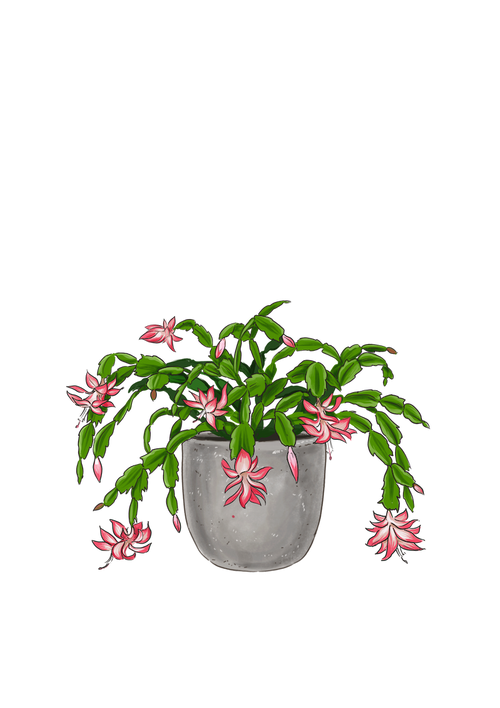Christmas Cactus Care Guide

-
Light : High
Bright, indirect light. Don't put into direct sun or it will bleach out their foliage.
-
Water : Low
Water your Christmas cactus when the soil is dry on the top inch. Always consider the environment and time of year. If your Christmas cactus is outdoors in a hot, dry climate, they may require watering every two to three days, since they are from a more tropical environment. If you treat them like an indoor plant where they stay in a cool or humid area, they might require water weekly. In the fall and winter months, decrease watering to stimulate blooming. Use filtered, bottled, or tap water sitting 24 hours to release the chemicals and water enough that the water discharges out of the drainage holes. Once the water is fully drained, replace them into the cache or decorative pot.
-
Humidity : High
The plant comes from the tropics and prefers a humid environment. Add them on a pebble tray filled with water but don't let the roots sit in water. Spritz them each day or add a humidifier next to it to maintain higher levels of humidity.
-
Temp : 50℉ - 80℉
The Christmas cactus does best in warm temperatures during the day between 70-80°F and night temperatures from 50-55°F. In the winter months, raise the nighttime temperatures inside to 60-65°F and avoid any drafts or heat vents nearby.
-
Zone : 9|10|11
The Christmas cactus does best in warm temperatures during the day between 70-80°F and night temperatures from 50-55°F. Bring inside to overwinter before a frost in the fall.
-
Fertilizer : Every two weeks
Water the plant before fertilizing to avoid fertilizer burn. Use a liquid fertilizer bi weekly throughout the spring and summer months, then stop during the fall and winter.
-
Repotting : 3 Years
When receiving the plant, do not repot immediately but wait at least 6-12 months. Repot in the spring, using a 2" bigger pot to keep the roots drier. (Too big of a planter could cause the soil to dry slower, which is not helpful.) Hydrate the plant before repotting. Place a piece of screening at the bottom of the container over the drainage hole to secure the soil and allow them to drain. Use a succulent and cactus mix to repot when the plant becomes root-bound. This plant prefers a little less room around their roots to promote blooming, so if you skip a year, that's fine. Lift the plant and release the roots against the existing planter. Use a clean knife or garden trowel to wedge between the pot and the soil to loosen. Inspect the roots. Notice if there are any dead or rotting roots and trim off with sterile pruners. Ensure the plant is sitting about 1 inch below the edge of the pot to avoid water spillage. Add more soil and backfill around the sides by tamping down. Fill up to the soil line but not over. Water thoroughly, leaving the soil damp but not soggy. If settling occurs, add more soil. Water well to dampen the soil and let it drain.
-
Cleaning : As needed
Prune yearly if needed to tame unruly branches. Cut between two leaf segments. You can trim the entire plant down by a third each year if needed.
-
Propagation : Cuttings
Take the cuttings from pruning and let the cut ends heal for a few days to callus over. Leave them laid out on a paper towel. Afterward, place cut side down into succulent and cactus soil. Keep the soil lightly moist. Within two weeks, roots will form, and you'll have birthed new plant babies!















